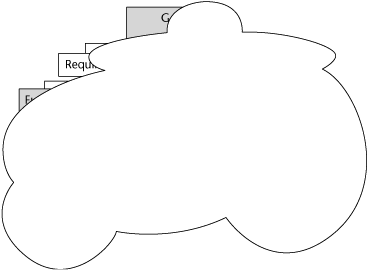The Scoping Phase of an Extreme SDPM Strategy
In the Extreme SDPM strategy the Requirements Breakdown Structure (RBS) from the Adaptive SDPM strategy is modified to look like Figure 32-1. You have very little knowledge of the goal (the solution) and very little knowledge of the requirements, functions, or features. Hence, you have a project that is not much different than a pure R&D project. Projects that follow an Extreme SDPM strategy are those for which both a complete RBS cannot be defined at the outset, and the customer and project team know it.
Figure 32-1. The initial RBS for an Extreme SDPM strategy

Figure 32-1 characterizes this by illustrating a cloud that covers the goal. So in this case, the goal and solution are both hidden by the cloud cover. The solution is represented by the requirements, functions, and features decomposition. The objective of the Extreme SDPM strategy is to move the cloud and discover what lies behind it—in other words, to learn and discover through iteration what the goal really is and how it can be reached. The Extreme SDPM strategy follows a path quite similar to the Adaptive SDPM strategy in that it must accommodate not only the development of the known parts of the solution but also discovery of the unknown parts of the solution, while, at the same time, defining the goal that the solution will attain. Discovering the goal and the solution ...
Get Effective Software Project Management now with the O’Reilly learning platform.
O’Reilly members experience books, live events, courses curated by job role, and more from O’Reilly and nearly 200 top publishers.

